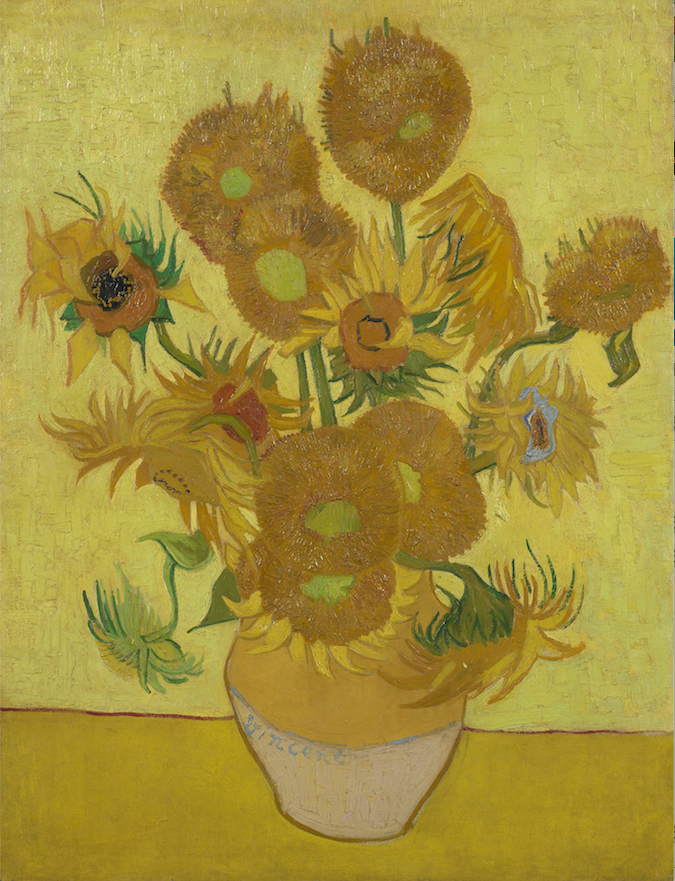AMSTERDAM -- In the summer of 1888, Vincent van Gogh invited his friend and fellow painter Paul Gauguin to visit him in Arles, France, and to stay with him at the house where he hoped to establish an artists' retreat. When Gauguin arrived in the fall, he found his room decorated with van Gogh's artworks, including a painting of sunflowers arranged in a ceramic vase against a yellow background.
The two-month visit ended disastrously. The two artists had a blowout fight, and van Gogh sliced off his ear, suffered a mental breakdown and ended up in the hospital. Gauguin fled back to Paris.
A couple of weeks later he wrote to van Gogh requesting that painting, Sunflowers, praising it as "a perfect page of an essential 'Vincent' style."
Understandably, van Gogh was reluctant to hand over what he felt might be his most accomplished work, so he decided to paint another version to exchange with a work by Gauguin. He completed that one in January 1889, but never sent it.
These two paintings, both called Sunflowers, are generally accepted as the finest of several depictions of the thick-stemmed, nodding blooms that van Gogh made in 1888 and 1889 during his time in Arles. The first is now in the collection of the National Gallery in London, and the second is in the Van Gogh Museum in Amsterdam.
Van Gogh referred to this work as a "repetition" of the London painting. But art historians and curators have long been curious to know how different this "repetition" is from the first. Should it be considered a copy, an independent artwork or something in between?
An extensive research project conducted over the past three years by conservation experts at the National Gallery and the Van Gogh Museum has concluded that the second painting was "not intended as an exact copy of the original example," said Ella Hendriks, a professor of conservation and restoration at the University of Amsterdam, who was the lead researcher on the project.
"Though the basic palette is the same, there were different colors that were used, differences in paint texturing, and his brushwork is different," she said.
Although both versions are too fragile to travel, it was possible to conduct a kind of virtual side-by-side comparison of the works using new mobile scanning technologies.
Rather than removing the paintings from the galleries for physical analysis, or taking invasive paint samples -- once common practice -- researchers brought mobile digital scanning devices into the museum that could map paint layers, brushwork and pigments without touching the artwork. They could then compare the data from each work.
The Van Gogh Museum shared this information before the opening of the museum's summer exhibition, "Van Gogh and the Sunflowers," which runs through Sept. 1. Along with the museum's Sunflowers, some 20 other works from the museum's permanent collection, mostly depicting flowers, are on display, along with two loans.
Nienke Bakker, the exhibition's curator, said the research helped to understand something more about the nature of van Gogh's relationship with Gauguin.
When Gauguin wrote to van Gogh praising the painting and asking for it, van Gogh was flattered but didn't want "to give it away," she said. "If Gauguin hadn't asked, who knows if the other versions would have been made."

All told, van Gogh painted 11 works in which sunflowers are the primary subject, and more in which they play a role, Bakker said. He made four of these in Paris, and seven in Arles. Of those seven, two have disappeared from public view: one was destroyed in a fire in Japan during an Allied bombing of Osaka during World War II; another is in a private collection that has not made the work available for loan to any museums, Bakker said.
There are five paintings in public museums that are generally thought of today as part of van Gogh's Sunflowers series, all of essentially the same bouquet in the same ceramic pot, set against either a yellow or a pale blue background. Apart from the London and Amsterdam versions, the other three are in Munich, Tokyo and Philadelphia.
Most are too fragile to travel. The National Gallery has only lent its painting three times: to the Van Gogh Museum in 2002 and 2013, and to the Van Gogh and Britain exhibition at Tate Britain across town, currently running through Aug. 11.
The Van Gogh Museum decided to stop lending its version last year, because conservators found that the chrome yellow pigments van Gogh used are unstable and could start to turn green and brown. To avoid changes already observed at a microscopic level from becoming visible, Bakker said, "you have to avoid vibrations and changes in climate, temperature and humidity."
The last time the National Gallery Sunflowers and the Van Gogh Museum Sunflowers were brought together was in 2013 and 2014, for jointly organized exhibitions at both institutions.
In this Van Gogh Museum exhibition, videos of five "Sunflowers" paintings are presented on adjacent screens, showing the works in their museum settings, and zooming in on details that are similar and different, so viewers can see how van Gogh's "repetitions" vary.
"It's impossible to reunite all of these paintings again," Bakker said. "It's rather sad, but on the other hand, we have to keep them and preserve them for future generations."
A book about Van Gogh's sunflower paintings, The Sunflowers Are Mine by Martin Brady, was published in 2013.
Style on 06/30/2019
